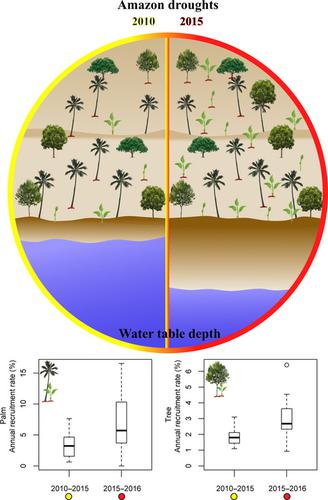Our official English website, www.x-mol.net, welcomes your
feedback! (Note: you will need to create a separate account there.)
Palms and trees resist extreme drought in Amazon forests with shallow water tables
Journal of Ecology ( IF 5.3 ) Pub Date : 2020-02-29 , DOI: 10.1111/1365-2745.13377 Thaiane R. Sousa 1 , Juliana Schietti 2 , Fernanda Coelho de Souza 2 , Adriane Esquivel‐Muelbert 3, 4 , Igor O. Ribeiro 5 , Thaise Emílio 6 , Pedro A. C. L. Pequeno 7 , Oliver Phillips 4 , Flavia R. C. Costa 2
中文翻译:

棕榈树与浅层地下水位抵御亚马逊森林的极端干旱
更新日期:2020-02-29
Journal of Ecology ( IF 5.3 ) Pub Date : 2020-02-29 , DOI: 10.1111/1365-2745.13377 Thaiane R. Sousa 1 , Juliana Schietti 2 , Fernanda Coelho de Souza 2 , Adriane Esquivel‐Muelbert 3, 4 , Igor O. Ribeiro 5 , Thaise Emílio 6 , Pedro A. C. L. Pequeno 7 , Oliver Phillips 4 , Flavia R. C. Costa 2
Affiliation

|
- The intensity and frequency of severe droughts in the Amazon region have increased in the recent decades. These extreme events are associated with changes in forest dynamics, biomass and floristic composition. However, most studies of drought response have focused on upland forests with deep water tables, which may be especially sensitive to drought. Palms, which tend to dominate the less well‐drained soils, have also been neglected. The relative neglect of shallow water tables and palms is a significant concern for our understanding of tropical drought impacts, especially as one‐third of Amazon forests grow on shallow water tables (<5 m deep).
- We evaluated the drought response of palms and trees in forests distributed over a 600 km transect in central‐southern Amazonia, where the landscape is dominated by shallow water table forests (SWTF). We compared vegetation dynamics before and following the 2015–2016 El Nino drought, the hottest and driest on record for the region (−214 mm of cumulative water deficit).
- We observed no change in stand mortality rates and no biomass loss in response to drought in these forests. Instead, we observed an increase in recruitment rates, which doubled to 6.78% year‐1 ± 4.40 (M ± SD) during 2015–2016 for palms and increased by half for trees (to 2.92% year‐1 ± 1.21), compared to rates in the pre‐El‐Nino interval. Within these SWTF, mortality and recruitment rates varied as a function of climatic drought intensity and water table depth for both palms and trees, with mortality being greatest in climatically and hydrologically wetter environments and recruitment greatest in drier environments. Across our transect, there was a significant increase over time in tree biomass.
- Synthesis. Our results indicate that forests growing over shallow water tables—relatively under‐studied vegetation that nonetheless occupies one‐third of Amazon forests—are remarkably resistant to drought. These findings are consistent with the hypothesis that local hydrology and its interactions with climate strongly constrain forest drought effects, and has implications for climate change feedbacks. This work enhances our understanding of integrated drought effects on tropical forest dynamics and highlights the importance of incorporating neglected forest types into both the modelling of forest climate responses and into public decisions about priorities for conservation.
中文翻译:

棕榈树与浅层地下水位抵御亚马逊森林的极端干旱
- 近几十年来,亚马逊地区严重干旱的强度和频率有所增加。这些极端事件与森林动态,生物量和植物组成的变化有关。但是,大多数干旱响应研究都集中在地下水位较高的山地森林上,这对干旱特别敏感。棕榈树经常在排水不畅的土壤中占主导地位,也被人们忽略了。浅层地下水位和棕榈树的相对疏忽是我们对热带干旱影响的理解的重要关注点,尤其是当三分之一的亚马逊森林生长在浅层地下水位(<5 m深)上时。
- 我们评估了分布在中南部亚马逊地区600公里横断面上的森林中棕榈树和树木的干旱响应,那里的景观主要由浅水表森林(SWTF)主导。我们比较了2015–2016年厄尔尼诺(El Nino)干旱前后的植被动态,这是该地区有记录以来最热和最干旱的(累积缺水量-214 mm)。
- 在这些森林中,我们观察到林分死亡率没有变化,也没有因干旱引起的生物量损失。相反,我们观察到招聘率有所提高 ,相比之下,2015-2016年间,棕榈树的征聘率翻了一番,达到6.78%- 1年 ±4.40(M ± SD),树木增长了一半(达到2.92%- 1年±1.21年)。 El-Nino之前的时间间隔中的费率。在这些SWTF中,棕榈树和树木的死亡率和补充率随气候干旱强度和地下水位深度的变化而变化,在气候和水文湿润的环境中死亡率最高,而在较干燥的环境中死亡率最高。在整个样带中,树木生物量随时间显着增加。
- 综合。我们的结果表明,生长在浅水区上的森林(相对研究不足,但仍占亚马逊森林的三分之一)对干旱具有显着的抵抗力。这些发现与以下假设相吻合:当地水文学及其与气候的相互作用强烈地限制了森林干旱的影响,并且对气候变化的反馈具有影响。这项工作增进了我们对综合干旱对热带森林动态影响的理解,并强调了将被忽视的森林类型纳入森林气候响应模型以及有关保护重点的公共决策中的重要性。











































 京公网安备 11010802027423号
京公网安备 11010802027423号